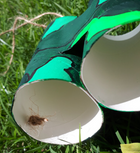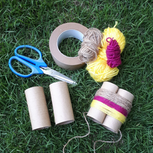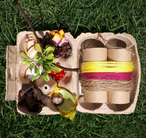Nature at Home Series: Develop your skills as a Nature Explorer
- Claire

- May 3, 2020
- 4 min read
Nature walks often feature in our weekly Wildlings Forest School sessions. They give us an opportunity to slow down and use all of our senses to soak up the nature around us, paying attention to, and appreciating, the little things. Plus, they are great fun, we never know what we will find! Read on to find out how to make more of your daily exercise walks with your children.
Part One: Observation Skills
It is all too easy to walk around outdoors and not really SEE what is all around us. Just today we walked past a bush full of caterpillars! On closer inspection, we also saw many chrysalis and at least three newly eclosed butterflies, right in our neighbourhood. Now each time we walk this way we will stop and check on our little friends.
Here is a nature hunt suitable for children aged 3-6 years that encourages the development of observational skills. Encourage your children to look up, down and around for some of the things we see regularly outdoors in Singapore.
Deepen the learning by encouraging your child to share their thoughts on what they have seen. You may ask questions like:
Where have we seen these before?
Do we see these often?
How does it feel?
Does it smell?
What do you think it is doing?
Tick off each item you find, or take a photo and create a nature collage to print out at home.

Part Two: Investigating Natural Items
If your home is like ours you may have pebbles, shells, crystals, feathers, pinecones and other natural items collected by your children over time, often from holidays, or scavenged from wrapping or decorations and so on already scattered around.
Now would be a good time to bring these items together in your child's own Nature Treasure Box.
Firstly, encourage your child to make a simple box, like this one made from an egg carton. This can be an opportunity to be creative. You can use the pictures here, or find pictures online, to inspire your child.

Next, go on a scavenger hunt together around your home to see what items from nature you can find that you already have. You may be surprised!

Look through the items that you found and try some of these questions:
What is this one called?
Do you remember where we got this? Ask your child to share any memories with you. For example, the image above contains a Tiger Cowrie shell (a common type of sea snail). I asked my son if he could remember where it came from and he remembered a holiday to Australia, a trip to a market and choosing from a selection of shells (I was assured they were sustainably farmed).
Do you know where this comes from? (On our hunt we found a Banksia Seedpod which we use for essential oils)
What words can we use to describe the things we have found?
Lastly go for a nature walk around your HDB estate, or condo, balcony or garden and see what you can add to your box. Let your child explore these items and arrange them for a photo. Keep only the items that are dried out, return the perishable items to nature on your next walk.
Part Three: Make your Own Binoculars for a Different Perspective

Now you’re used to paying attention to nature on your walks why not make your very own binoculars to help you see nature from a different perspective. These are always somewhere in our Forest School kit bag and it’s really easy to create your own homemade versions with some basic stuff, just two toilet rolls, tape and coloured string or ribbons.
Step by step instructions:
Collect your supplies - do you know where to find these items for yourself in your home?
Do you like using tape? Get your tape and tape the string to one roll, leave a little hanging at the end to tie off with later.
Wrap your string round and round until you have a nice pattern and the tubes are secured and you're happy with it. Your tubes shouldn't wobble.
Tie the end of the string with the excess left from the starting end. If it's tricky, you could always tape the end too.
Make a small hole on each outer side of the tubes at one end. You can try to poke through a sharp pencil to make your holes or ask your grown-up for help.
Cut a piece of string or ribbon big enough to create a neck strap that will fit over your head, about 50cm long.
Feed the string through the holes, tie with a double knot if you know how to do it, or you could tape the end of the ribbon to the main part of the strap as well.
Decorate as you wish.
Enjoy your next trip outdoors with your homemade nature kits! If you have a go at these activities please share any photos with us via email to hello@wildlings.sg or WhatsApp to +65 8157 0533 so that we can share the inspiration with our community.
About Kelly
New to Singapore Kelly is an experienced Forest School practitioner from the UK. Kelly loves the outdoors, hiking and flapjacks (they're a kind of energy bar....). With experience in nature therapy, Kelly most loves the special moment of surprise and the wonder of discovery in a child when encountering something new for the very first time.



















Comments